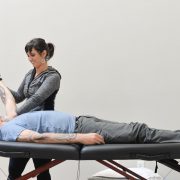Why Your Neck Stretches Aren’t Working
Do you suffer from chronic neck pain and ever wonder…
Why don’t my neck stretches work?
Even though you’ve Googled and YouTubed them about a hundred times…
There are a few reasons why stretching your neck might not be doing anything to help get rid of your neck pain.
- Your technique could be off
- You could be doing the wrong stretch
- It could be that you just shouldn’t be stretching your neck at all!
Let’s go over the different reasons why your neck stretches might not be working… and most importantly… what you can do about it.
1. You’re doing it wrong.
Although research studies are inconclusive regarding how long you should hold a particular stretch, most people feel good when they hold a stretch for 30-60 seconds. When it comes to technique, one of the biggest problems I see is not relaxing enough. If you’re tense, or gripping your muscles at the same time you’re stretching, it won’t work very well. It’s important to breathe and move easily into the stretch. If you try to force it or push through pain, you’ll likely tense up.
Now let’s say you’re doing everything right (not tensing or gripping) but your stretches still don’t seem to work.
Some people (myself included) respond better to “moving stretches”. This is where instead of holding one static position for a prolonged period – you repeatedly move through one or several end-range stretches. Neck rolls are a great example of this.
If your neck stretches haven’t been working, try adjusting the way you’ve been stretching… if it works… then you were likely just using the wrong technique.
2. You’re doing the wrong type of stretch.
This one could be a little tougher to figure out on your own. There is a difference between corrective neck stretching and stretching to feel good.
For example, let’s say your neck is tightening up because you’ve been under a lot of stress or you just did a lot of activity that impacts your neck. Generic neck stretches such as bringing your chin to your chest, or pulling your chin to the opposite shoulder (known as an “upper trap stretch”) may be all you need.
In fact, I do stretches like this regularly because I’m constantly leaning over to help patients. I stretch my neck to PREVENT it from having problems and because it feels good.
But let’s say you already have a neck problem, or you have pain or numbness running down your arm.
In these instances, generic neck stretching could make you worse.
You likely need corrective stretches, like what we prescribe for patients in our office.
Corrective stretches are specifically prescribed to address your particular problem in your neck – and are very different from the generalized stretches that are designed to feel good and relieve tension.
If you think you might need corrective stretches for your neck – DO NOT google them – you must see a specialist and have them prescribed to you.
3. You shouldn’t be stretching your neck at all!
This is a very common problem we see… folks come in with complaints of chronic tightness and discomfort in their neck and no matter how often they stretch or massage, it doesn’t go away.
Did you know that chronic neck tightness can be a sign of a weak core?
It’s quite common – and if that is the case for you – no amount of stretching will help – and could even aggravate your problem!
The deep, stabilizing muscles of your neck are connected by fascia to the deep muscles of your core. If your deep core is not working properly, then your neck will often kick in and try to help.
Ever notice that your neck is always sore or tight after a good ab workout?
This could be a sign that your neck is compensating for your core.
Stop stretching your neck, learn how to strengthen your core the right way, and see a specialist who can help you.
In our office, our team of specialists work alongside our Pilates instructors to help folks improve their core strength from the inside out – so that their necks and backs stop getting involved.
If you’re dealing with chronic neck problems that aren’t’ responding to stretching…
There’s a good chance you could be not stretching correctly, the stretches aren’t right for you, or you’ve completely missed the root cause of your neck pain and you shouldn’t be stretching at all!
Want to work with our team of specialists and finally get some help for your neck problem?
CLICK HERE to request a free Discovery Session with one of our specialists.
They’ll set up a time to talk to you about what’s going on with your neck. If you’re a good fit for what we do, then they will help you get started!
This is only for people serious about getting help…
And for those that are finally ready for a long-term solution to their pain – one that will put an end to constantly relying on pain pills – and help you avoid expensive procedures and risky surgery.











